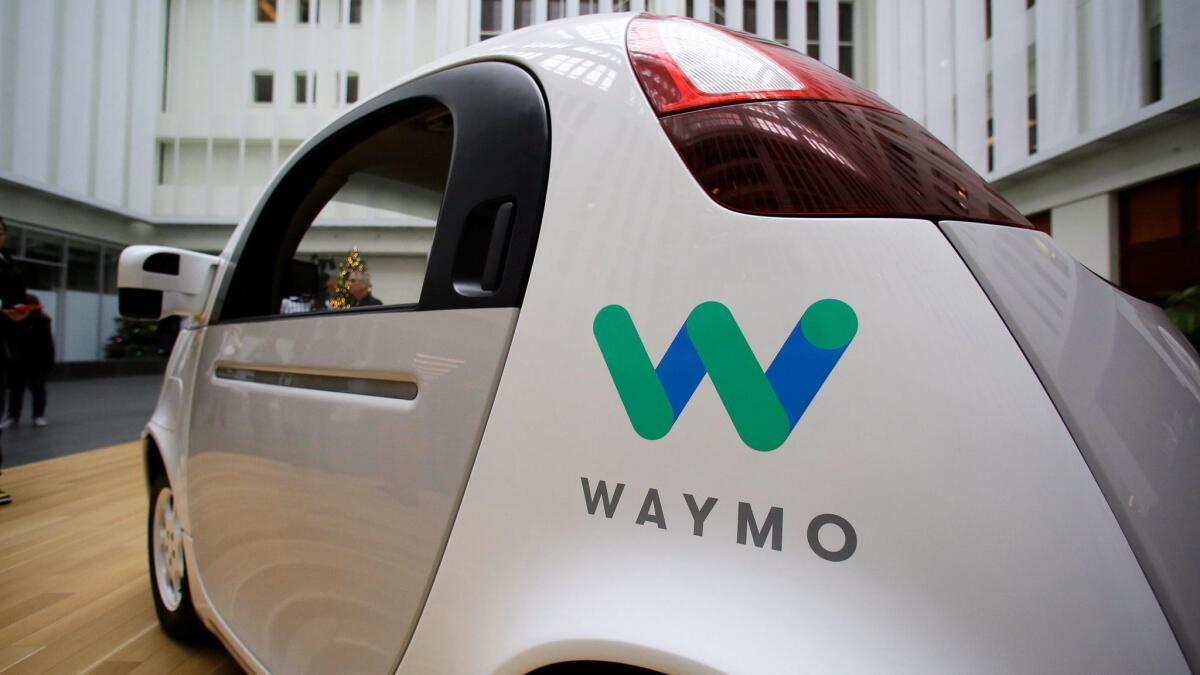Waymo is the first company to give a detailed self-driving safety report to federal officials

To help keep tabs on the safety of driverless cars rolling around U.S. cities, the federal government last year, and again last month, suggested that tech firms and car companies submit safety checklists.
None of the companies have done it.
Until now.
Waymo, a self-driving car project spun off from Google, submitted a 43-page safety report to the U.S. Department of Transportation on Thursday, offering the most detailed description yet of how it — or any other company — equips and trains vehicles to avoid the range of mundane and outrageous problems that are part of U.S. driving.
“We’ve staged people jumping out of canvas bags or porta-potties on the side of the road, skateboarders lying on their boards, and thrown stacks of paper in front of our sensors,” says the report, which describes how company engineers use a 91-acre California Central Valley test facility mocked up like a city, as well as computer simulations covering hundreds of thousands of variations of possible road scenarios.
The National Highway Traffic Safety Administration has suggested a set of 28 “behavioral competencies,” or basic things an autonomous vehicle should be able to do. Some are exceedingly basic (“detect and respond to stopped vehicles,” “navigate intersections and perform turns”); others, more intricate (“respond to citizens directing traffic after a crash.)
Waymo lists an additional 19 examples of challenges it uses for testing, including that its cars must be able to “detect and respond” to animals, motorcyclists, school buses, slippery roads, unanticipated weather and faded or missing road signs.
The company — which is owned by Google’s parent company, Alphabet Inc. — says it has used federal data on human crashes to focus its efforts on improving its software-and-sensor drivers. Top problem-scenarios for flesh-and-blood drivers include rear-end crashes, turning or crossing at intersections, running off the edge of the road, and changing lanes. So those “figure prominently in the evaluation of our vehicles,” according to the report.
And then numerous riffs are created on them.
“We can multiply this one tricky left turn to explore thousands of variable scenarios and ‘what ifs?,’” the report says. “The scene can be made busier and more complex by adding ... joggers zigzagging across the street.”
Although such reports are now voluntary, the House and Senate have each passed bills that would require companies to submit safety assessments in the coming years.
Some road-safety advocates argue that driverless cars should be required to pass explicit safety tests before being unleashed on the roads, just as human drivers are. And they say the federal government has taken a dangerously laissez-faire approach to the burgeoning industry.
But with tens of thousands of people killed each year on U.S. roads alone, driverless firms promise big improvements overall. Waymo executives say their safety report is part of an effort to be more transparent about their experiences, which they hope will be good for public understanding — and business.
“This overview of our safety program reflects the important lessons learned through the 3.5 million miles Waymo’s vehicles have self-driven on public roads, and billions of miles of simulated driving, over the last eight years,” Waymo Chief Executive John Krafcik said in a letter Thursday to U.S. Transportation Secretary Elaine Chao.
The report offered a view into the way Waymo’s software breaks down the 360 degrees of data constantly pouring in from radar, laser sensors, high-definition cameras, GPS and an audio detection system the company says can hear sirens hundreds of feet away.
First is perception, which is where the vehicle classifies objects and stitches them into a “cohesive real-time view of the world,” Waymo said. That means distinguishing between cars and people, and also bicyclists and motorcycle drivers.
Next is modeling and predicting the behavior of the object it encounters. So, for example, the software knows that walkers move more slowly than bikers of either variety, but also that pedestrians can change direction more abruptly.
Then the pieces come together in what the company calls its “planner,” which figures out where the car will actually go and is imbued with a “defensive driving” sensibility, according to the report. It keeps the car out of the blind spots of nearby human drivers, gives cyclists extra room and games out what’s coming several steps ahead of time, like a biker likely to dodge an upcoming road blockage.
But cars, like humans, can’t think of everything. How well they manage that reality — and deal with the unexpected — will help determine how good they really are.
“You can’t expect to program the car for everything you’re possibly going to see,” said Ron Medford, Waymo’s safety director and a former senior National Highway Traffic Safety Administration official. Extensive driving experiments feed simulations that essentially give the car experience, which helps greatly.
And if it really doesn’t know what to do, he said, it can pull over safely.
Laris writes for the Washington Post.






